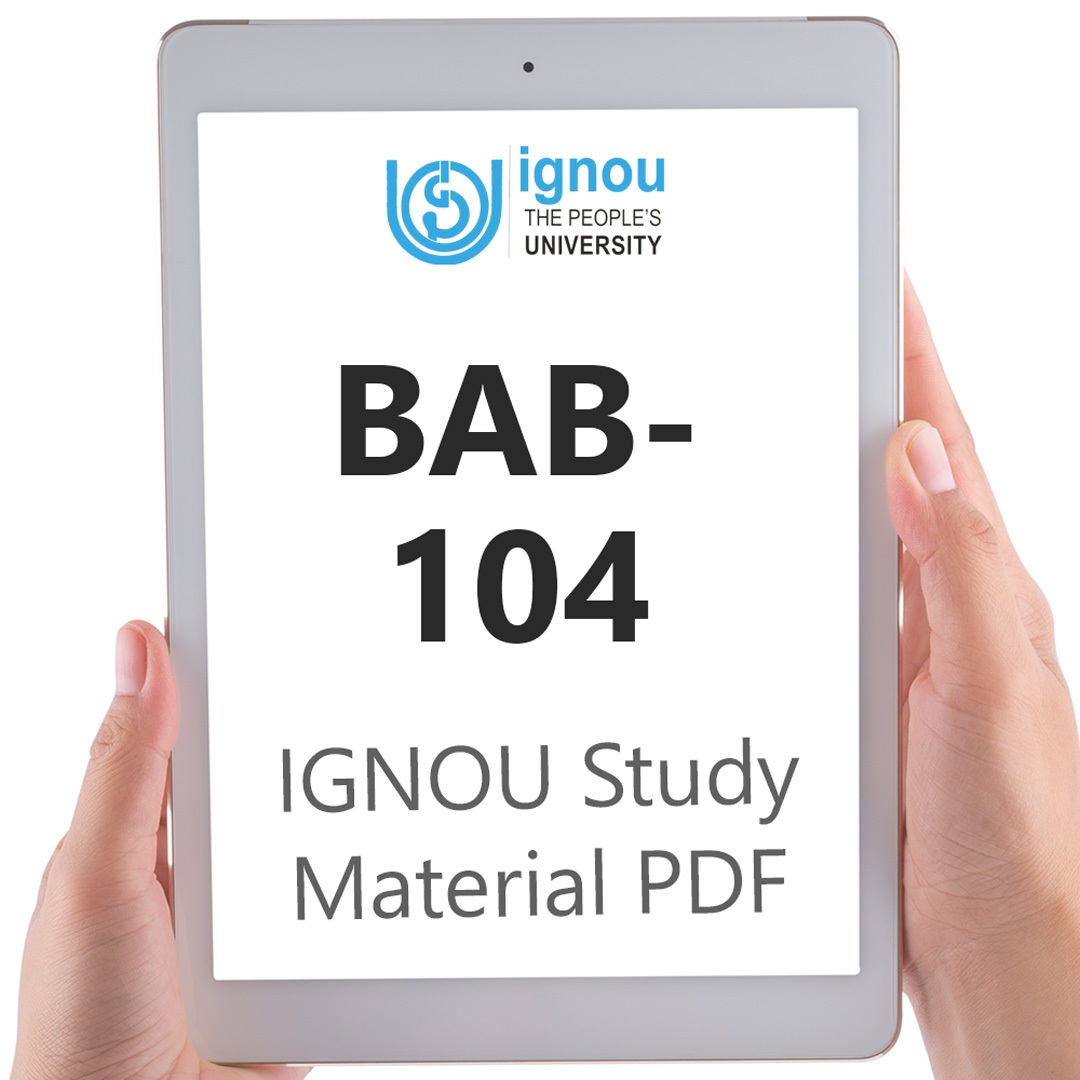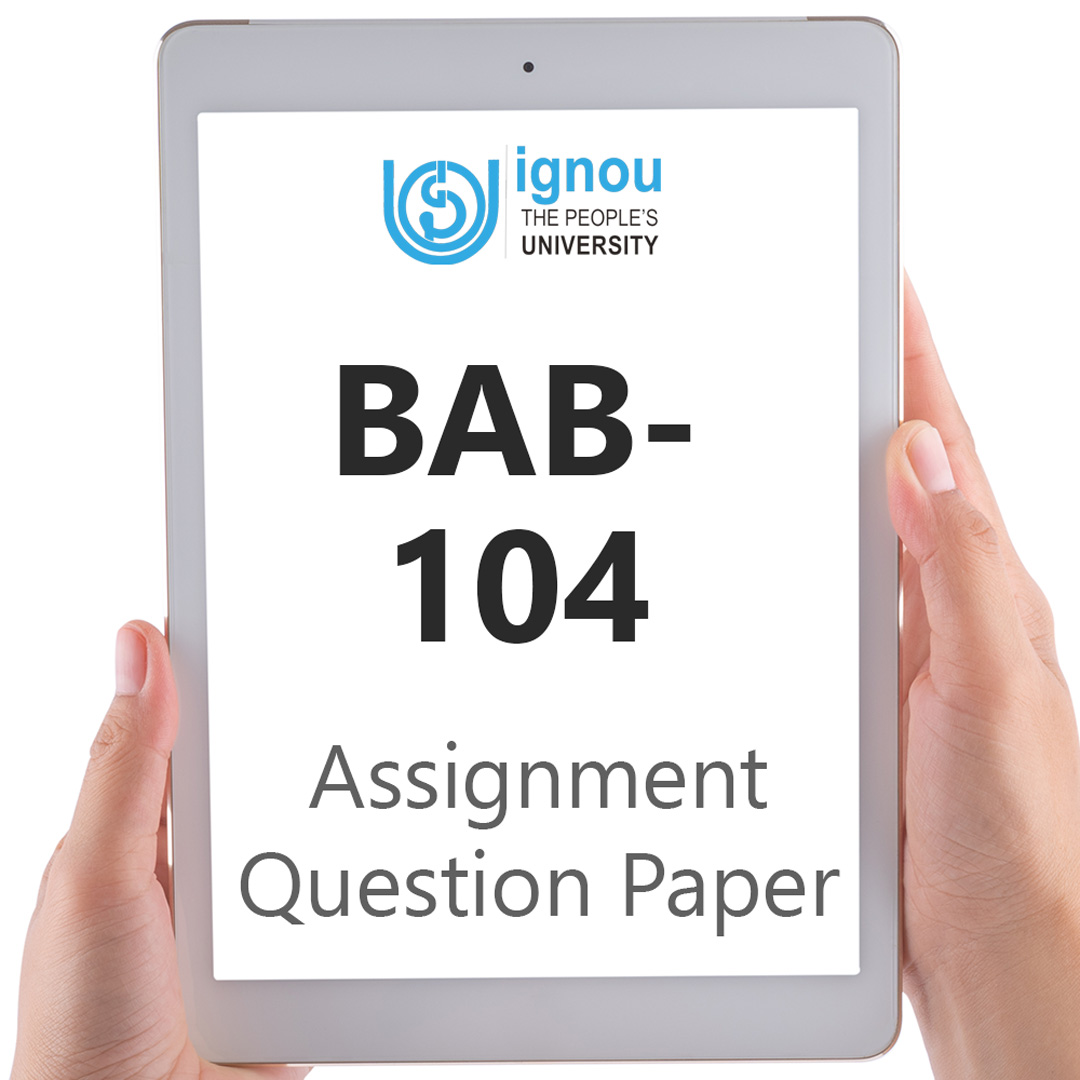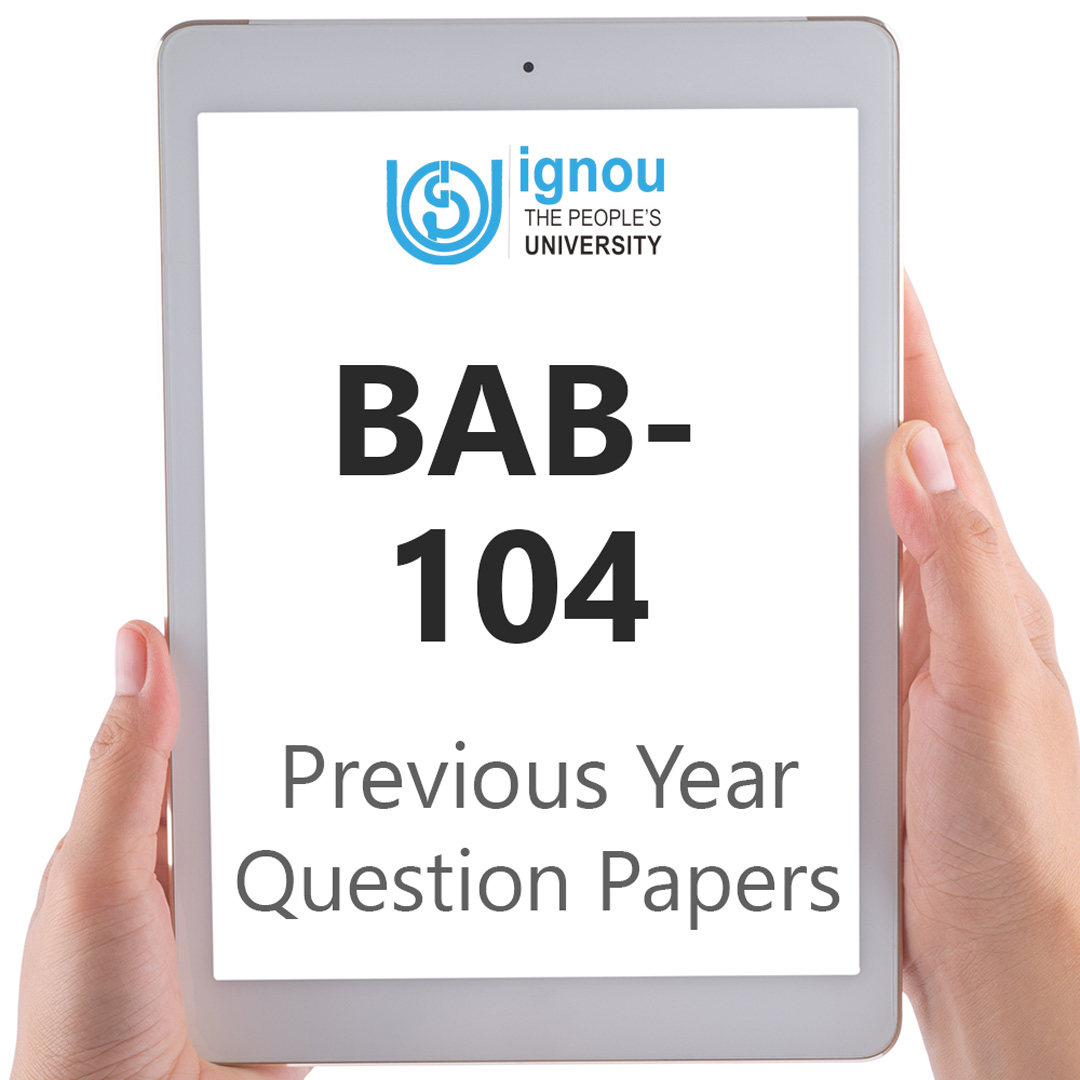If you are looking for BAB-104 IGNOU Solved Assignment solution for the subject State, Democracy and Nation Building, you have come to the right place. BAB-104 solution on this page applies to 2022-23 session students studying in CLTA courses of IGNOU.
BAB-104 Solved Assignment Solution by Gyaniversity
Assignment Code: BAB-104/TMA/2022-23
Course Code: BAB -104
Assignment Name: State, Democracy and Nation Building
Year: 2022-2023
Verification Status: Verified by Professor
SECTION A
Marks: 100
Weightage - 30%
Note: Attempt any Five Questions. All Questions carry equal marks (20x5).
1. Discuss Ambedkar’s idea of nation and nation-building.
Ans) We will now analyse Ambedkar's plan for creating a nation. We can emphasise three features of it. Realizing that India was not a nation at the outset can be considered the first step in nation-building. He asserted that the sooner we recognise that we are not yet a nation, the sooner we will understand the necessity of doing so and begin to seriously consider the means by which to accomplish this.
The establishment of rights for the three oppressed groups, namely Dalits or ex-untouchables, Muslims, and Hindu women, was the third component of Ambedkar's plan for building a nation. However, Ambedkar emphasised that, "Philosophically it may be possible to consider a nation as a unit but sociologically it cannot help but be regarded as consisting of many classes and the...nation if it is to be a reality must vouchsafe that the freedom of the different classes comprised in it, particularly those who are treated as serve 201–202 (Ambedkar 1991) Ambedkar saw ex-untouchables (Dalits), members of the Backward Classes, Muslim women, and Hindu women as the most subservient groups that required special consideration during the process of nation-building.
Nation-building and the Question of Self representation of Deprived Sections
Ambedkar favoured ex-untouchables (Dalits) having their own representation in the executive branch, cabinet, bureaucracy, etc. Ambedkar expressed his thoughts in his written submission on franchise to the Southborough Committee in 1919, defining its significance. Ambedkar (1979: 247) argued that no person as such should be denied the opportunity to actively participate in the process of government because government is the most significant arena for the exercise of individual capacities. In other words, popular government is government not just by the people but also for the people. The representation of opinions by themselves does not make up popular government, to put it another way. It also requires personal representation to conceal its true meaning (Ambedkar 1979: 247).
Inclusion of Dalits and Backwards in Different Institutions of Governance
Ambedkar continued to advocate for ex-untouchables (Dalits), non-Brahmins, and Muslims to be represented in the administration through nomination as opposed to competition. Because he was aware that for some people, "administration appears to be nothing more than the process of applying law as enacted by the legislative," he took this action (ibid). Ambedkar argues that administration today entails much more than simply reading statutes to understand the rules of the state, though.
Nowadays, a government department is frequently given broad rulemaking authority due to time constraints or for convenience (ibid). He further argued that, It must be accepted as unquestionable that such broad powers of rule-making affecting the welfare of large classes of people cannot be safely left in the hands of the administrators drawn from one particular class which, as a matter of fact, is opposed to the rest of the population in its motives and interests, (which) does not sympathise with the living forces operating in them, is not charged with their wants, pains, cravings, and desires, and is not charged with their needs and wants.
2. What are Ambedkar’s view on democracy and citizenship? Discuss.
Ans) Ambedkar believed that democracy implied a companion life. The endosmosis process was what connected the individuals to the groups. According to his opinion, democracy is a social structure in which there is both room for social change and a shared interest by all members of the group.
The location of society becomes significant when the state assumes dominance and disregards it. Only a democratic society can uphold the rights to freedom and equal opportunity for all of its members and foster the personal growth of both the individual members and the entire society. Therefore, he saw democracy as more of a social structure than a form of government. Ambedkar based his definition of citizenship on Dewey's theory of associated life.
Ambedkar described the social endosmosis process as being blocked in Indian society due to caste-based divisions. He used the Deweyian term "social endosmosis" to describe this phenomenon. The varnashram dharma, which was predetermined by birth, was followed by Indian society. Due to this, different castes became isolated from one another and were infected with an antisocial spirit, which had an adverse effect on the state's citizens' sense of fraternity.
Ambedkar asserts in Annihilation of Caste that merely coexisting in close proximity does not cause individuals to form a society. Caste kept people from assimilating into one cohesive society. The caste system, which was based on occupational stratification, determined membership by birth. Although the Brahmins, Vaishyas, Kshetriyas, and Shudras followed the same varna system, they were forbidden from intermarrying. These castes existed in watertight compartments.
The isolation of the lower classes and the exclusivity of the upper classes had bred a spirit that shunned social development. Ambedkar wrote in the manuscript "Away from the Hindus" that the establishment of kinship was the only way to end the social exclusion of the "untouchables." Religion is based on kinship, whereas society is based on citizenship. Buddhism was promoted by Ambedkar. He stated, "I was born as a Hindu but shall not die like one," in a letter to Gandhi. 10 He was disgusted by Hinduism's adamantly conservative, narrow-minded beliefs that arose from gradated inequality determined by birth. He adopted Buddhism as a result and saw it as a form of Navayana liberation theology, a new means of travel for a new journey toward liberation and a new identity.
In 1956's second Dhamma chakra Pravartan, he applied Buddhism to society's more extensive political life. In his article "Contextualizing Ambekarian Conversion," Ramesh Kamble11 looked at how Ambedkar not only viewed Buddhism's egalitarian, liberal, and fraternal principles as privileges but also saw it as a critique of the Brahmanic chaturvarnya system, which was at odds with the Buddha's idea of a just moral order. But in general, Ambedkar found the elements, functions, and targets of the society he sought to create through his counter-hegemonic struggle in the thorough reading of Buddha and his dhamma. Thus, one of the most crucial weapons in the struggle to transform religious, spiritual, and political aspects was conversion.
3. When were the Round Table Conferences held? Discuss.
Ans) The British Government made the decision to host a number of Round Table Conferences in London in response to the Simon Commission Report's shortcomings. They took place in three stages in London:
from 16 November 1930 to 19 January 1931
from 7 September to 1 December 1931
from 17 November to 24 December 1932.
While maintaining its repressive policies, the British government also pursued a course of compromise and reform. Round table discussions only served as a reflection of it. The first Round Table Conference was not attended by the Indian National Congress. However, there were representatives from:
the Princely states
the Hindu Mahasabha (M.R. Jayakar and B.S. Munje)
the Sikhs and
The Depressed Classes (B.R. Ambedkar).
Ambedkar made a direct connection between Swaraj and the liberation of the Dalits. However, he was also unwilling to cede the Dalits' political future to the benevolence of the upper castes. Gandhi was against creating separate electorates for the poor. In his letter to Ramsay MacDonald before starting the fast at Yeravada jail, Gandhi stated that his real objection to separate electorates for the Depressed Classes was that "it would destroy Hinduism," not that it gave too little to the Depressed Classes. It is true, however, that Gandhi himself condemned the untouchability practise that was prevalent in the Hindu society of the time and began an anti-untouchability campaign to raise Hindus' awareness of the injustices suffered by the harijan (as Gandhi referred to them) community.
He also made the Harijans aware of their status and rights. However, Ambedkar was not pleased with Gandhi's political stance or his credentials. He harshly criticised Gandhi's strategy for dealing with the issues of the Depressed Classes, which involved using truth and ahimsa to persuade the Hindus to change their ways. The two great leaders got into a personality conflict as a result of Ambedkar's vehement criticism.
4. Write a note on importance of reservation policy in India.
Ans) Some of the formerly recognised groups were listed as Scheduled Castes (SC) and Scheduled Tribes (ST) in the Indian Constitution (their meaning and description is provided later in this unit). In Indian society, these were the groups that experienced discrimination and oppression. Therefore, the Constitution gave SCs and STs special protections to safeguard their economic and educational interests. Three types of reservation are provided by the Constitution:
Political reservation (Articles 330 and332)
Reservation in educational institutions (Articles 15(4)and 46)
Reservation in government jobs (Articles 16(4), 320(4), 333 and335)
The said class of citizens is socially and educationally backward
The said class is not adequately represented
12.5 percent and 5% of seats, respectively, were set aside for SCs and STs at the time the Constitution was promulgated. The percentage of reservation for SCs and STs was increased and fixed at 15% and 7.5% respectively on March 25, 1970, because the censuses of 1951 and 1961 showed an increase in their population. The Supreme Court set a 50% cap on reservation in 1963 under M.R. Balaji vs. Mysore AIR 1963, which meant that no state could increase the number of reserved posts above 50% of the total vacancies.
In 1979, the Mandal Commission was established, which was a significant step in the development of India's reservation system. This commission was created to evaluate the state of communities with weak social and educational systems. The Other Backward Classes (OBCs) category was added, and it was suggested that the existing quotas be changed to raise them from 22.5 to 49.5 percent. The Mandal Commission's recommendations were accepted and put into practise by the VP Singh administration in 1990.
In 1995, Parliament passed the 77th Constitutional Amendment and added article 16(4), which facilitated the SCs and STs' reservation in promotion. This was another historic act. In the 2005 case of P.A. Inamdar & Others Vs. State of Maharashtra & Others, the Supreme Court ruled that the state cannot impose its reservation policy on professional institutions that are run independently by minorities and non-minorities. The 93rd Constitutional amendment was passed by Parliament in 2005 specifically to lessen the effects of this judgement. This made room for reservations for SCs and STs as well as other underrepresented groups in private educational institutions. Therefore, the total constitutional reservation at this time is 49.5%. A portion of this is set aside for SCs, STs, and OBCs at 15%, 7.5%, and 27%, respectively.
6. What was Ambedkar’s understanding of the party system in India.
Ans) Ambedkar recognised the value of political parties in a democracy. He believed that courage was the key to freedom in a democracy. And this bravery was expressed in a political party, which was a group of people. Therefore, a party was required to run a government. He acknowledged that political parties were a necessary component of popular government, but he was critical of any party's rule and viewed it as the antithesis of popular government.
He highlighted how one-party rule in western democracies like Germany and Italy had contributed to the rise of totalitarian states in those nations. Therefore, he issued a warning to the nation against praising a one-party system in the name of national unity. Any such action, in his opinion, would expose democracy to the dangers of tyranny and the potential for mismanagement of the public interest that come with a one-party system. In a democracy, single-party rule restricted it to being merely formal. Even putting it through elections would not have protected it from despotism. The best defence against despotism is to present it with the possibility of being overthrown, brought low, or replaced by a rival group.
In order to run a government, you need a party. But in order to prevent a government from turning despotic, two parties are required. Only when two parties are working together—the party in power and the party in opposition—can a democratic government continue to be democratic. Without a powerful opposition, democracy is impossible. Ambedkar was also vehemently opposed to India adopting the British-style party system. He clarified that the foundation of the British political system is the assumption that a party will win the majority, or a political majority. In India, however, the majority will always be a communal majority, regardless of the social and political platform of a party.
Therefore, adopting the British system would permanently give the communal majority executive power in India. Additionally, under the British system, the majority party is not required to appoint members of the minority party to the government. If it were applied to India, the majority community would become the ruling class and the minority community would become the subject race. It would entail giving a communal majority the freedom to run the government however it sees fit, regardless of what is best for the minorities. Ambedkar made it abundantly clear that such a situation cannot ever be referred to as a democracy.
Ambedkar believed that the conflicts between castes and creeds in India's current system of "graded inequality" would inevitably result in the rise of numerous parties and groups in the legislature. If this occurs, India will experience executive instability because of the British parliamentary model, which mandates that the executive resign upon a negative vote in the legislature. For it is simple for groups to align and realign frequently, even for trivial goals, and bring about the overthrow of the government. He preferred the American executive model over the British one because it had some improvements.





